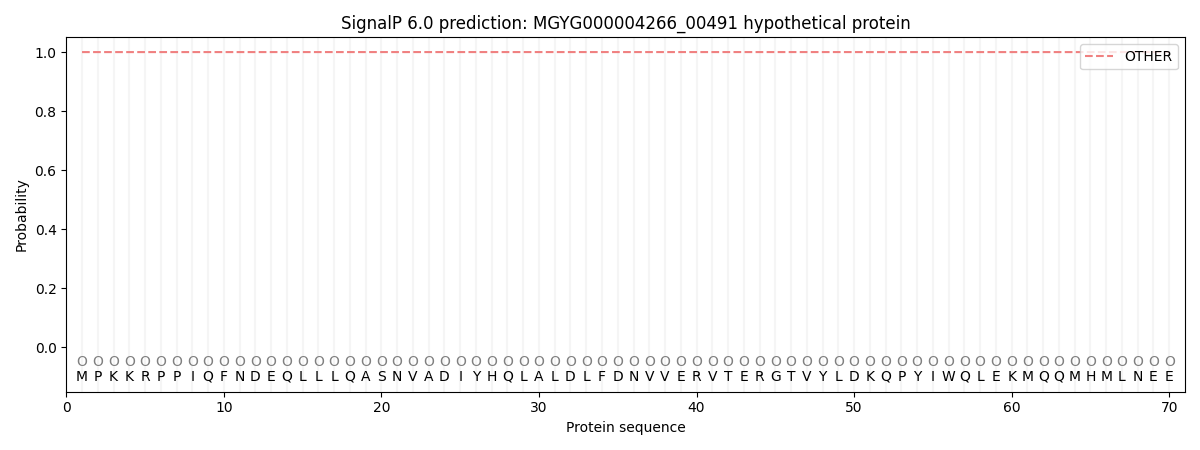You are browsing environment: HUMAN GUT
CAZyme Information: MGYG000004266_00491
You are here: Home > Sequence: MGYG000004266_00491
Basic Information |
Genomic context |
Full Sequence |
Enzyme annotations |
CAZy signature domains |
CDD domains |
CAZyme hits |
PDB hits |
Swiss-Prot hits |
SignalP and Lipop annotations |
TMHMM annotations
Basic Information help
| Species | Streptococcus sp900550895 | |||||||||||
|---|---|---|---|---|---|---|---|---|---|---|---|---|
| Lineage | Bacteria; Firmicutes; Bacilli; Lactobacillales; Streptococcaceae; Streptococcus; Streptococcus sp900550895 | |||||||||||
| CAZyme ID | MGYG000004266_00491 | |||||||||||
| CAZy Family | GH0 | |||||||||||
| CAZyme Description | hypothetical protein | |||||||||||
| CAZyme Property |
|
|||||||||||
| Genome Property |
|
|||||||||||
| Gene Location | Start: 4092; End: 5771 Strand: - | |||||||||||
CDD Domains download full data without filtering help
| Cdd ID | Domain | E-Value | qStart | qEnd | sStart | sEnd | Domain Description |
|---|---|---|---|---|---|---|---|
| pfam06152 | Phage_min_cap2 | 3.08e-116 | 11 | 366 | 2 | 367 | Phage minor capsid protein 2. Family of related phage minor capsid proteins. |
| cd13442 | CDI_toxin_Bp1026b-like | 1.92e-23 | 424 | 535 | 1 | 113 | C-terminal (CT) toxin domain of the contact-dependent growth inhibition (CDI) system of Burkholderia pseudomallei 1026b, and related proteins. CDI toxins are expressed by gram-negative bacteria as part of a mechanism to inhibit the growth of neighboring cells. This model represents the C-terminal (CT) toxin domain of CdiA effector proteins. CdiA secretion is dependent on the outer membrane protein CdiB. Upon binding to a receptor on the surface of target bacteria, the CDI toxin is delivered via the C-terminal domain. A wide variety of C-terminal toxin domains appear to exist; this particular example from Burkholderia pseudomallei 1026b and other bacteria appears to function as a Mg2+-dependent RNAse cleaving tRNA, most likely in the aminoacyl acceptor stem. This CdiA-Ct is structurally similar to another CDI toxin domain from B. pseudomallei E479 which is unrelated in sequence but has a similar nuclease domain, and shares similar fold and active-site architecture; it contains a core alpha/beta-fold that is characteristic of PD(D/E)XK superfamily nucleases. |
| pfam18451 | CdiA_C | 2.66e-18 | 472 | 550 | 1 | 81 | Contact-dependent growth inhibition CdiA C-terminal domain. Contact-dependent growth inhibition (CDI) systems encode polymorphic toxin/immunity proteins that mediate competition between neighboring bacterial cells. CDI is mediated by the CdiB/CdiA family of two-partner secretion proteins. This domain represents the C-terminal of CdiA proteins (CdiA-CT), which contains the CDI toxin activity. The C-terminal nuclease domain forms a stable complex with its cognate immunity protein. It is also sufficient to inhibit growth when expressed in E. coli cells, consolidating the idea that they constitute the functional CDI toxin. The CdiA-CT C-terminal domains are structurally similar to type IIS restriction endonucleases suggesting that the toxins have metal-dependent DNase activity. |
| cd20727 | CDI_toxin_Bp_tRNase-like | 0.002 | 469 | 528 | 30 | 89 | C-terminal (CT) toxin domain of a contact-dependent growth inhibition (CDI) system (CdiA-CT) similar to that of Burkholderia pseudomallei, and related proteins. CDI toxins are expressed by gram-negative bacteria as part of a mechanism to inhibit the growth of neighboring cells. This model represents the C-terminal (CT) toxin domain of CdiA effector proteins. CdiA secretion is dependent on the outer membrane protein CdiB. Upon binding to a receptor on the surface of target bacteria, the CDI toxin is delivered via the C-terminal domain. A wide variety of C-terminal toxin domains appear to exist; this particular model contains the C-terminal (CT) toxin domains that are similar to Burkholderia pseudomallei E479 and 1026b CdiA toxins, both of which are tRNAses. |
CAZyme Hits help
| Hit ID | E-Value | Query Start | Query End | Hit Start | Hit End |
|---|---|---|---|---|---|
| CAQ57830.1 | 2.00e-187 | 3 | 381 | 2 | 380 |
| ACR45913.1 | 2.52e-162 | 4 | 381 | 3 | 381 |
| AEQ24916.1 | 4.28e-155 | 4 | 381 | 2 | 378 |
| AAK33642.1 | 6.06e-155 | 4 | 381 | 2 | 378 |
| AAT87498.1 | 6.06e-155 | 4 | 381 | 2 | 378 |
Swiss-Prot Hits download full data without filtering help
| Hit ID | E-Value | Query Start | Query End | Hit Start | Hit End | Description |
|---|---|---|---|---|---|---|
| Q04765 | 6.18e-42 | 17 | 381 | 1 | 368 | Structural protein OS=Lactococcus phage LL-H OX=12348 PE=3 SV=2 |
| Q04766 | 9.84e-11 | 262 | 380 | 7 | 120 | Structural protein (Fragment) OS=Lactococcus phage mv4 OX=12392 PE=3 SV=1 |
SignalP and Lipop Annotations help
This protein is predicted as OTHER

| Other | SP_Sec_SPI | LIPO_Sec_SPII | TAT_Tat_SPI | TATLIP_Sec_SPII | PILIN_Sec_SPIII |
|---|---|---|---|---|---|
| 1.000067 | 0.000000 | 0.000000 | 0.000000 | 0.000000 | 0.000000 |
